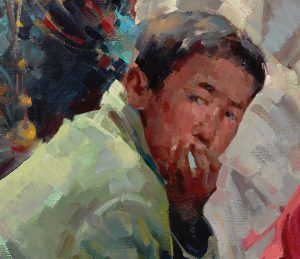Looking at paintings up close reveals so much
by Kristin Hoerth

Jove Wang, Harvest in Tebiet (detail), oil, 40 x 44.
This story was featured in the July 2016 issue of Southwest Art magazine. Get the Southwest Art July 2016 print issue or digital download now–then subscribe to Southwest Art and never miss another story.
I am always fascinated by the surfaces of paintings. Maybe that’s because I’m not an artist myself, so there’s a certain sense of mystery I feel about paint and its many personalities. I tend to walk right up to an artwork to inspect it at close range, and I’m amazed by the many different ways paint can be applied and manipulated depending on the quantity and tools that are used and the effects that the artist wants to achieve.
This month in particular, I’m struck by the wide range of techniques used to put down paint by the artists whose work is featured in our pages. On one end of the spectrum is Slade Wheeler, one of this month’s Artists to Watch (page 20), who creates trompe l’oeil works. Wheeler’s surfaces are meant to fool the eye into believing that what you’re seeing is not paint on canvas depicting, say, a single match, but rather the actual match itself. “I like to dive into the details,” Wheeler says. “I can enjoy painting rust on an object. On a micro level, so much can be revealed.”
For Jove Wang, on the other hand, visible brush strokes are an essential method of expression. Wang is part of a two-man show at Waterhouse Gallery this month (page 38). “My brush strokes show my ideas of emotion,” he says. “They are a directional guide for form and structure, passage of movement, even defining edges.” In the painting detail shown here, notice how few strokes are used to convey the contours of the boy’s face and how those strokes vary in value from light to dark. Even though the eyes are merely suggested by a few daubs of dark brown and blue paint, the tone of his glance is so clearly communicated.
There are still more approaches to applying paint on display in this month’s pages. Jean Richardson (page 34) uses a palette knife to achieve thick impasto areas; those carefully placed knife marks leave visible ridges that add to the composition. And Deb Komitor (page 84) starts with a black background and then applies thick strokes of saturated colors on top, so that the black remains visible in between the lighter strokes. No matter which methods produce the results that speak to you, it’s always worth getting a close-up view of these fascinating surfaces.
Featured in the July 2016 issue of Southwest Art magazine. Get the Southwest Art July 2016 print issue or digital download now–then subscribe to Southwest Art and never miss another story.
MORE RESOURCES FOR ART COLLECTORS & ENTHUSIASTS
• Subscribe to Southwest Art magazine
• Learn how to paint & how to draw with downloads, books, videos & more from North Light Shop
• Sign up for your Southwest Art email newsletter & download a FREE ebook





